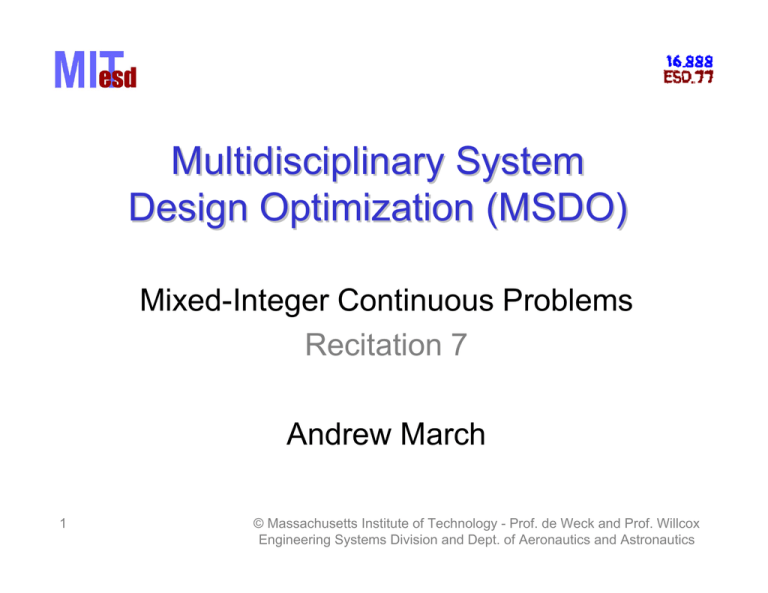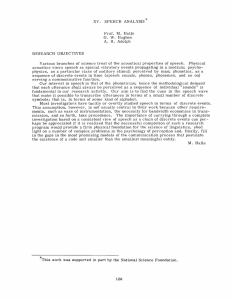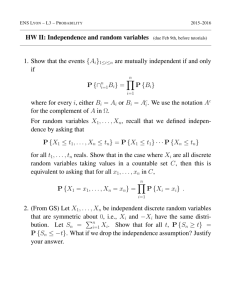Document 13564172
advertisement

Multidisciplinary System
System
Design Optimization (MSDO)
(MSDO)
Mixed-Integer Continuous Problems
Recitation 7
Andrew March
1
© Massachusetts Institute of Technology - Prof. de Weck and Prof. Willcox
Engineering Systems Division and Dept. of Aeronautics and Astronautics
Today’s Topics
Topics
• What a mixed-integer problem looks like
• I am skipping the theory…
• Options to solve them
– Direct Search
– Gradient-Based methods
• Direct
• Indirect
– Heuristic Techniques
• SA
• GA
• PSet 4, A2 Discussion
2
© Massachusetts Institute of Technology - Prof. de Weck and Prof. Willcox
Engineering Systems Division and Dept. of Aeronautics and Astronautics
What a MIO Looks Like
• At least one discrete
variable
• At least one
continuous variable
• Example:
min f (x) = x T x
s.t. − 5 ≤ x1 ≤ 5, x1 ∈ ℑ
− 5 ≤ x2 ≤ 5
Problem:
• No gradient in discrete direction.
– What are optimality
conditions?
min f (x) = x T x
s.t. − 5 ≤ x1 ≤ 5, x1 ∈ ℑ
− 5 ≤ x2 ≤ 5
Constrained Version
• No gradient in discrete
direction.
– What are optimality
conditions?
min f (x) = x T x
s.t. − 5 ≤ x1 ≤ 5, x1 ∈ ℑ
− 5 ≤ x2 ≤ 5
x1 + x2 ≤ 2
Solution Techniques: Direct Search
• Use a direct search method
– Simplex method, where one direction always
takes a unit step
– Compass search (easy to set-up)
Gradient-Based Algorithm
• Fix discrete variables
and optimize
continuous
• Use a DoE technique for discrete variables
– Full-factorial expansion
– Latin-Hypercube
– Random starting points
• Gradient-based
optimization for
continuous.
Gradient-Based: Indirect
1. Convert all discrete variables to continuous
variables
2. Use typical gradient based algorithms on
continuous variables
3. Round final continuous variables to nearest
feasible discrete value
•
Problems:
– Not possible for all problems.
– Finding nearest feasible discrete value may be
difficult
– Answer might be quite poor.
Gradient-Based: Response Surface
1. Generate a response surface:
⎡1 x11
⎢
1 x12
X =⎢
⎢M M
⎢
⎣1 x1n
x21
x11 x21
x122
x22
M
x2n
x12 x22
M
x1n x2n
x122
M
x1n2
2
⎤
x21
2 ⎥
x22
⎥
M ⎥
2 ⎥
x2n
⎦
Least-Squares Solution:
X T Xβ = X T F
β = [β1 β 2 β 3 β 4 β 5 β 6 ]
f (x12 , x22 ) L
j=sample point #
Solve for β:
Xβ = F
T
F = [ f (x11 , x21 )
xij i=dimension
f (x1n , x2n )]
T
2. Optimize the response surface
3. Round discrete variables, and check
function value/convergence.
a. Recalibrate response surface locally and
repeat?
Heuristic Techniques Overview
• Generally easy to setup MIO problems.
• Brute force?
• No convergence guarantee.
Simulated Annealing
• Easy to accommodate
integer variables:
• Example:
min f (x) = x T x
s.t. − 5 ≤ x1 ≤ 5, x1 ∈ ℑ
− 5 ≤ x2 ≤ 5
• Possible random
perturbations:
Categorical Distribution
– x1=x1+C(-1,0,1)
– x2=x2+N(0,1)
Normal Distribution
P(x1)
P(x2)
1/3
1
1
x1
1
1
x2
Genetic Algorithm
• Can you use a real-valued-GA?
• Can you use a discrete-GA, for instance
binary encoded?
– Could use ternary, etc.
Binary Encoding Example
• Binary encoded GA (Lecture 11)
•
⎛ x − xLB ⎞
ln⎜ UB
⎟
Δx
⎠
nbits = ⎝
ln 2
Δx =
(xUB − xLB )
•
2nbits
• How many bits are needed?
–
–
–
–
–
Continuous variables on a computer? Integer variable, x∈{1,2,3,4}?
Integer variable, x∈{1,2,3,4,5}?
Continuous variable, x∈[0,1], Δx=0.1?
Continuous variable, x∈[0,1], Δx=0.01?
Problem 2 on A4
Side View
Front View
nIbeams=3
w
b
t
d
3 Discrete Variables
nIbeams
Ibeam Material
Support Material
5 Continuous Variables
t, b, h, w, d
h
Summary
• Mixed-discrete continuous problems can be
complicated.
• Formal theory is complex, and gradientbased methods have difficulty.
– Can be smart with DoE techniques
• Heuristic algorithms can be considered brute
force, but typically can be made to optimized
mixed-discrete continuous problems.
– Just need to let them run forever.
MIT OpenCourseWare
http://ocw.mit.edu
ESD.77 / 16.888 Multidisciplinary System Design Optimization
Spring 2010
For information about citing these materials or our Terms of Use, visit: http://ocw.mit.edu/terms.





